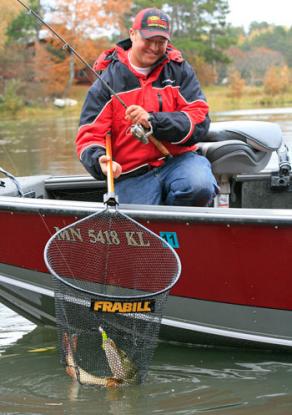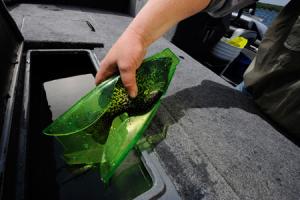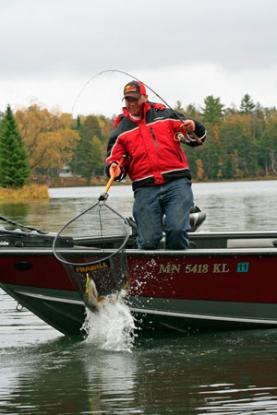 Have you ever caught the same fish twice in a single day? How about the same fish two or three times inside a week? I’ll bet many of you have. Even on a massive fish factory like Mille Lacs in Central Minnesota, these daily doubles occur more often than we probably realize. Last year, for instance, fishing a particular shallow weed flat, we caught a hungry 27-inch walleye with an odd black spot on its tail. Only reason I remember it is because the very next day, a client caught what had to be the exact same walleye. Three days later, when the marked fish ate my Fire-Ball jig once more, it was like seeing an old friend—Dottie the hungry walleye. Hope she’s still swimming out there— chomping on perch and the occasional jig and leech.
Have you ever caught the same fish twice in a single day? How about the same fish two or three times inside a week? I’ll bet many of you have. Even on a massive fish factory like Mille Lacs in Central Minnesota, these daily doubles occur more often than we probably realize. Last year, for instance, fishing a particular shallow weed flat, we caught a hungry 27-inch walleye with an odd black spot on its tail. Only reason I remember it is because the very next day, a client caught what had to be the exact same walleye. Three days later, when the marked fish ate my Fire-Ball jig once more, it was like seeing an old friend—Dottie the hungry walleye. Hope she’s still swimming out there— chomping on perch and the occasional jig and leech.
You’re probably wondering why I’m telling you this. It really isn’t to convince you that you actually are smarter than the fish (most of us). Instead, I want to tell you that the next time you pull one of these daily doubles, you ought to pat yourself on the back. You’ve done your job well— not only as a skilled angler, but even more as a caretaker of fish.
Catching and releasing larger individual fish like Dottie isn’t just a great idea. In more and more lakes each season, special length and slot limits require it. Even when you’re selectively harvesting smaller, more numerous fish, enjoying them at dinner means caring for the catch. Keep them healthy in your livewell, or fresh on ice, all the way up to the fillet table. Harvesting a limit of small walleyes or crappies, then allowing them to spoil in the sun is a tragedy.
Still, much of the time these days, we’re releasing most of the fish we catch. And that means doing everything possible to assure their health and survival. Released fish can be hurt in a number of ways, but they all relate to stress and wounding. Most stress occurs between the hookset and landing. Wounding, on the other hand, can result from hooks, as well as poor handling practices. We can’t always prevent fish from stressing themselves during a long fight, but we can certainly prevent problems related to improper handling. Whether I’m fishing for bass, walleyes, muskies or even big crappies, I almost always rely on a landing net. Frabill’s Conservation Series nets are like big swimming pools for fish. Slip a big walleye into one, and just keep the net draped over the side of your boat, fish calmly paddling around inside. Keep the fish in the water, while you quickly remove hooks. If it’s a pike, say “AH” and get the Mouth Spreaders.
Now, if you want a photo, leave the fish safely in its “holding pen,” and ready the camera. The fish remains in the water and happy while you prepare. You’re doing everything necessary to assure a safe, healthy release. When you’re ready, wet your hands, and then lightly grip the gill cover with one hand, supporting its lower abdomen with the other. Snap your shots, and immediately lower the fish back into the water. If it doesn’t immediately swim away, hold the fish gently by the tail, and just let it pump its gills and draw oxygen. Do not thrust the fish back and forth. Fish don’t swim backward, and they’re gills aren’t able to extract oxygen from water when you do this. Simply hold them in place underwater, and they’ll do the rest. If you’re in a river, face the fish upstream, not down.
In summer, consider that when surface water temperatures surpass the 70-degree mark, it’s best to minimize the time you spend fighting fish, handling them boatside. If possible, avoid removing them from the water altogether. Again, a fish-friendly net like my Conservation Series is the best catch-and-release tool in my boat. The net’s special design keeps the catch relaxed in soft, padded netting. While a spacious interior and flat bottom panel supports their entire body, protecting its anatomy and preserving fin structure.
 If I’m fishing for panfish, I usually set my own release size standards. I never keep bluegills over 8-inches. And for crappies, anything over 11-inches goes back. There’s this really cool device called the Grip ‘N Check (it’s also called the Crappie E-Z Checker) that greatly eases the measuring process. Slide the fish into the measuring basket and you get an instant accurate length. A lot of states now have crappie size limits, and this little gadget makes quick work of accurately measuring panfish. It also assures that fish can’t flip-flop away, causing damage to gills, fins or scales.
If I’m fishing for panfish, I usually set my own release size standards. I never keep bluegills over 8-inches. And for crappies, anything over 11-inches goes back. There’s this really cool device called the Grip ‘N Check (it’s also called the Crappie E-Z Checker) that greatly eases the measuring process. Slide the fish into the measuring basket and you get an instant accurate length. A lot of states now have crappie size limits, and this little gadget makes quick work of accurately measuring panfish. It also assures that fish can’t flip-flop away, causing damage to gills, fins or scales.
Few other things I like to do to care for my catch. One involves hooks. Excessively large barbs on some hooks can do plenty of damage to fish. First, though, consider that rarely are three treble hooks required on plugs—particularly those on big crankbaits. Consider removing one set of trebles, the middle set, in particular. Lots of times, an extra set simply means a greater chance that one tine will lodge into an eyeball or penetrate a gill.
Beyond that, I like to reduce the size of the barb on hooks. File a three-sided knife-edge on larger single or treble hooks, reducing the barb by half or more. Reduced-barb hooks penetrate easier, still hold plenty firm, and pop free with much less effort or damage to fish. It’s a small step that can make a huge difference, not only in terms of fish survival, but also in hookset success.
 A little about fish caught from deepwater. When certain fish are brought up from depths greater than 40 feet too fast, their swim bladders— which control buoyancy— can overinflate. You see a bubble in their throat, and the fish has trouble swimming back down. Sometimes, you can get fish to release (burp) air from their swim bladder by massaging and gently pressing on its abdomen. Some anglers do what’s called fizzing—puncturing the bladder with a hypodermic needle to relieve air pressure. I highly discourage this practice. Fizzing (puncturing) often does more harm than good, even if you know exactly what you’re doing. The third option is to burp fish with a small, smooth end tube. Take a 14-inch section of ½-inch PVC pipe, and sand the end smooth. Gently insert the tube into the fish’s throat several inches, until you hear (or feel) that the air has been released. Again, improper or forceful procedure here can damage fish. This may, however, be the safest, most effective means of burping fish.
A little about fish caught from deepwater. When certain fish are brought up from depths greater than 40 feet too fast, their swim bladders— which control buoyancy— can overinflate. You see a bubble in their throat, and the fish has trouble swimming back down. Sometimes, you can get fish to release (burp) air from their swim bladder by massaging and gently pressing on its abdomen. Some anglers do what’s called fizzing—puncturing the bladder with a hypodermic needle to relieve air pressure. I highly discourage this practice. Fizzing (puncturing) often does more harm than good, even if you know exactly what you’re doing. The third option is to burp fish with a small, smooth end tube. Take a 14-inch section of ½-inch PVC pipe, and sand the end smooth. Gently insert the tube into the fish’s throat several inches, until you hear (or feel) that the air has been released. Again, improper or forceful procedure here can damage fish. This may, however, be the safest, most effective means of burping fish.
Finally, a tip for deeply hooked fish. Holding the line in one hand, keep the hook eye exposed in the throat. Using a set of long, curved forceps, slide the closed grips through a gill opening. Frabill offers a slick catch and release tool kit, perfect for this scenario. Grasp the upper portion of the hook shank, then twist and push it back outward, completely freeing it. Using a hook with a reduced barb, this procedure has been shown to greatly minimize damage to fish. Fish swallow sharp spiny things all the time, and wounds in the larynx usually heal quickly. Certainly, this is safer for the fish than cutting the line, leaving a hook lodged in its throat.
The beauty of fishing today and that we have the knowledge and tools to care for the very fish that make what we love to do possible. Not only are things like the right net an insurance policy against lost boatside brawlers, they’re also invaluable for keeping fish healthy, happy, and hungry enough to bite again tomorrow.










